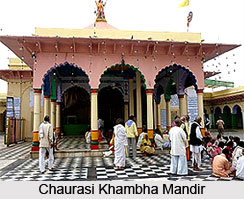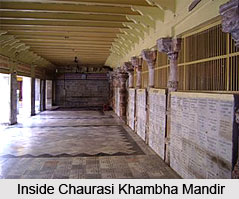 Chaurasi Khambha Mandir is a Hindu temple in Mahavan, situated in Mathura district of the Indian state Uttar Pradesh. It is regarded as the most significant and famed temple of the region. Also known as Nanda Bhavan, it is believed to be the place where Lord Krishna spent his childhood, his first three years along with his foster parents Nanda Rai and Yashoda. The walls of this yellow coloured temple are adorned with a number of paintings portraying the playfulness of Krishna. It is called Nanda Bhavan as it was the residence of Nanda Rai. It has also acquired the name Chaurasi Khambha which refers to 84 pillars owing to the presence of 84 pillars inside it.
Chaurasi Khambha Mandir is a Hindu temple in Mahavan, situated in Mathura district of the Indian state Uttar Pradesh. It is regarded as the most significant and famed temple of the region. Also known as Nanda Bhavan, it is believed to be the place where Lord Krishna spent his childhood, his first three years along with his foster parents Nanda Rai and Yashoda. The walls of this yellow coloured temple are adorned with a number of paintings portraying the playfulness of Krishna. It is called Nanda Bhavan as it was the residence of Nanda Rai. It has also acquired the name Chaurasi Khambha which refers to 84 pillars owing to the presence of 84 pillars inside it.
Legend of Chaurasi Khambha Mandir
As per the legends, Kansa had assigned the task of killing Lord Krishna to Shakatasura who had no body and was invisible. He had lost his physical form when he tried to uproot all the trees in a sage"s hermitage and as he was very proud of his strong body, the sage cursed him that he would lose his physical form. On asking for forgiveness, the sage told him that he would get Moksha in the Dwapara Yuga. With the orders of killing Lord Krishna, he proceeded towards Gokul. Infant Krishna was then playing in the cradle placed in the courtyard and although Shakatasura was invisible Lord Krishna spotted him with his divine vision. Shakatasura assumes the form of a cart and races towards the cradle for crushing the child with all his might but nothing happens. After his repeated attempts Krishna finds out that it is a demon in disguise and kicks the cart with his small legs which makes the cart fly in air and it then came down thrashing on the floor. It breaks and Shakatasura dies but he also receives Moksha when Lord Krishna"s body touches him.
 Deities of Chaurasi Khambha Mandir
Deities of Chaurasi Khambha Mandir
According to the beliefs, there are about 84, 00,000 species of life in the world and each pillar of Chaurasi Khambha Mandir is believed to represent 1, 00,000 species. Thus the temple symbolizes all forms of life of the universe. The temple hosts enormously huge idols of deities. A colossal idol of Balarama is placed at the centre while the idol of Nanda Maharaja stands on the left. The idol of Yashoda is on the right. There is also a cradle placed below with the idol of infant Krishna. The priests of the temple allow the devotees to swing the cradle of infant Lord Krishna.
Chatti-Palana Temple
Inside Chaurasi Khambha Mandir or Nanda Bhavan there lies the Chatti-Palana Temple. It is said that the Chatti Puja was performed on the sixth day after the birth of Lord Krishna in this temple and this ceremony also rendered the name to the temple. The temple is devoid of any idol however there is a huge painting on its wall. Yashoda holding Krishna and Rohini holding Balarama has been depicted in the painting. Myths say that the temple was previously a cowshed and the naming ceremony for Balarama and Krishna was conducted here on the sixth day. However others believe that the cowshed was located a few metres away from Nanda Bhavan and the painting in Chatti-Palana Temple is only the depiction of the naming ceremony.





















